The Best Family Games: For Children and their Parents
As a learning games researcher, I’ve become fascinated to observe just how easily children of all ages will discard their video games, and climb into their kitchen table seats, eager to play a card game or a board game with their families, often intuiting the rules long before the adults finish explaining them.
Children have a keen sense of fairness. They will leap into what’s difficult, but can be easily discouraged. Nothing is more pleasing than a guiding adult who still lets them lead. For a truly bonding experience, there’s nothing like a game you can enjoy with your family.
What follows is my handmade list of games for adults to play with children (with Amazon links).
(If you click on my links when ordering these games, rather than searching for them in separate windows, I receive a bonus from the stores, which I appreciate since it helps me maintain this website's information.)
It is a short list on purpose, since I am only comfortable recommending games I have personally played and studied, without overly complex rules. You will find very few “party”-type games here, since most importantly, these are the best games for teaching critical thinking.
You mean you can play games with your child while making him or her smarter? Yes!
Joe Bisz is a learning games researcher who delivers speaking engagements for K-12 and college teachers as well as corporations. See joebisz.com.
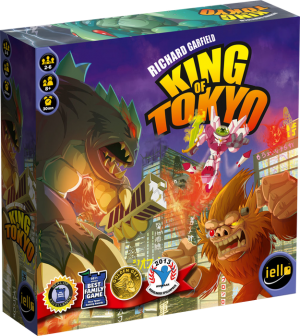
KING OF TOKYO
Buy It!: Amazon ($19.86)
Age Range with Adult Supervision: Ages 4+.
Number of Players: 2-6 players. Best with 3 or more players; it’s a much weaker game with 2 players.
Description: The first task a child gets to do is to pick his or her favorite monster from the giant game tokens available, each of which has really incredible cartoon-monster art. This starting act should give you an indication of the kind of fun you’re about to have. The rest of the game consists of throwing dice and drawing cards, which result in various effects: growing your monster, attacking other player monsters, or destroying the hapless city beneath your beast. Since there is not much of a board, these actions are abstracted through symbols on the dice, as well as the vibrant cartoon art on the cards you drawn. Rather like Yahtzee, there is a good amount of tactical thinking in figuring out what actions you should try to roll for, so this can be an excellent game for coaxing your child towards deeper strategic thinking. Especially since the game is so much fun, even during turns when the child (or the adult) does not have any patience for thinking too hard. However, if the child is sensitive to other players attacking them with their pieces, or to being eliminated from a game, they might not enjoy this time, since they will have to sit out while the remaining players battle it out. On the other hand, the fact that a player’s monster can be eliminated (especially a parent’s) is also a source of great merriment for many children.
Other Tips for Playing With a Child: 5 year-olds should be able to read most of the cards alone, though the card’s effect on the game may have to be explained to them. If the child cannot read the cards, he or she may be able to memorize its effects by linking them to the picture alone; else, you will have to eliminate the cards from the game (or use only the simplest ones).
Reviews: http://www.theboardgamefamily.com/2012/08/king-of-tokyo-board-game-review/
Click on some of the small images in this review to see the amazing monster cartoon art.
A Note on Player Age Ranges: The advertised age ranges outside a board game’s box are not correct. I believe game publishers are stating the minimum ages for unaided play (i.e. without adult supervision), which is why almost all games list “Ages 8+” or “Ages 10+”. But I’ve discovered that the minimum age of your child can be much lower (see below). Of course, watch out for choking hazards if your child is under 3.
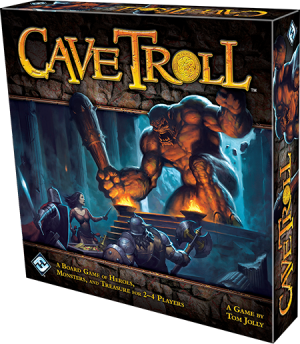
CAVE TROLL
Buy It!: Amazon ($29.95)
Age Range with Adult Supervision: Ages 5+.
Number of Players: 2-4 players. Best with 3 or more players.
Description: At first glance, the art suggests a dungeon-crawl type of game (“Ameritrash”) where the players kill lots of monsters by rolling lots of dice. Instead, we have a highly strategic, almost Chess-like positioning game that teaches thinking one or two moves ahead, while still providing the fun experience of placing monster and hero figurines on a dungeon board—and finding treasure! Since these are medieval fantasy figurines, they also suggest a Lord of the Rings-type theme that I know some children (ok, adults too) are particularly crazy about. You could even pretend these figurines are Lord of the Rings figures, and ask your child to name the figurines accordingly.
Other Tips for Playing With a Child: The first strategy that a child should learn is not to play a card that would result in the board being scored, unless the child would receive more points than everyone else. A harder strategy for children (ok, adults too!) to grasp is whether the actions you’re spending to move your pieces deeper in the dungeon would have been better spent simply drawing and playing more cards. This game reinforces counting and memory skills (counting up all the coins that indicate a player’s score, and comparing each score).
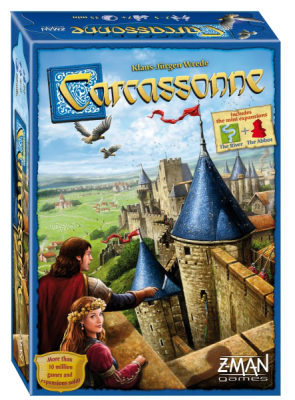
CARCASSONNE
Buy It!:
Amazon ($23.66)
Age Range with Adult Supervision: Ages 5+ (or possibly younger; see note)
Number of Players: 2-5 players.
Description: The game starts with only one tile in play, then like a jigsaw puzzle, tiles are drawn and placed until a medieval city of interlocking roads, castles, and farms is slowly built. Excitement increases as children watch the game board emerge through their choices of where to add their tiles. They also place tokens that turn into knights, thieves, and abbots, netting them points for completing images of the roads and cities. Although technically this is a competitive challenge, the game naturally lends itself to turns where players might help each other to complete their images. Winner of countless awards, this is one of the highest-rated and best-designed games of all time.
Other Tips for Playing With a Child: This game teaches spatial skills on a rigorous level, sometimes cooperation skills, and also how to weigh strategic options.
Reviews: http://geekdad.com/2014/12/carcassonne-2/
Expansions: "Carcassonne The Princess and the Dragon": Since the game has been a huge success, there are literally dozens of expansion games available. I strongly recommend purchasing “The Princess and the Dragon” expansion. Although it makes the game more random, children are delighted and intrigued by the giant Dragon token that wanders the board and possibly devours their followers, and the additional randomness can help balance the game for them against smarter adults.
Buy the Expansion! on Amazon ($14.99)
A Note on Expansions: Expansions are like “sequels” to a game. They add more pieces and rules to the game in an effort to increase the game’s replayability or expand its theme. You cannot play an expansion without owning the original game. If you try one of the games on my list, and the kids really enjoy it, consider buying an expansion.
Other Tips for Playing With a Child: Although I’ve played the full delightful game with 5-year olds, at this age you may have to avoid the rules for “Farmers,” since those rules are difficult to explain to a child under 8. If the child is younger than 5, some parents have found they enjoy simply putting together the game’s pieces like a puzzle, without actually following the game’s scoring structure.
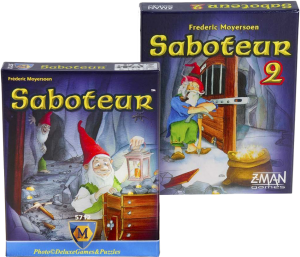
SABOTEUR
Buy It!:________________________________________________________ Amazon ($11.99)
Age Range with Adult Supervision: Ages 5+
Number of Players: 3-10 players. Best with 6-8 players.
Description: If you want a game that can handle up to 10 players, rewards but does not demand strategic thinking, and provides a lightly competitive and often amusing social experience, this is one of the few games that delivers. Each player takes on the role of a dwarf trying to dig his or her furious way out of a mine in order to find a hidden treasure. This involves each player laying down a tunnel card on their turn, which may bring the mine closer to the exit, or take the mine in a hopelessly (and amusingly) backward direction. But beware: one or more of the players are likely secret Saboteurs, who only wish to stop the rest of their fellow dwarves from finding a way out (and are likely the ones adding those backwards tunnels!). This social dynamic of mistrust absolutely carries the game and makes it deliciously entertaining as players try to bluff and figure out who has what secret agenda. Like the game Carcassonne, the game has few rules and no words, which makes it easier for young children to pick up.
Other Tips for Playing With a Child: This game teaches cooperating with others who may be on your same team, social dynamics and body language, as well as some spatial skills.
Reviews: http://fathergeek.com/saboteur/
Expansions: The original game is tremendously enhanced by the expansion game, which is called “Saboteur 2.” I absolutely insist that you buy the expansion game as well; it is what makes the game great.
Buy the Expansion! Amazon ($12.99)
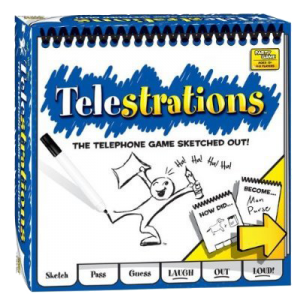
TELESTRATIONS
Buy It!:________________________________________________________ Amazon ($29.99)
Age Range with Adult Supervision: Ages 6+
Number of Players: 4-8 players. Best with 6 or more.
Description: This is a classic “party”-type game that is guaranteed to have everyone howling in laughter. The premise is that each player receives a different word, and then must draw an image of that word on a marker board. (Don’t worry; drawing skills are unnecessary. In fact, the game is better if you can’t draw well.) Players pass their boards to the next player, who see the drawn image but not the word, and then must write down (guess) the word that describes the image. Then they pass the marker boards again, and the next player must draw a picture of the new word. Like the classic game “telephone,” people’s interpretation of the image will slowly change, often in hilarious ways. Note that this same telephone mechanic means that the game’s humor works best with 6 or more people (enough people to guarantee that things go very wrong with the drawing). This is definitely not a strategy game, but it does teach vocabulary learning and interpretation skills to children. (If the dry erase markers the game contains run out of ink--and they will--simply buy another package in any office supplies store).
Reviews: https://boardgamegeek.com/thread/1423689/gaming-5-8-and-10-year-old-telestrations
This review gives excellent advice when very young children with a limited vocabulary are playing, such as to allow them to receive a new word if they don’t understand the word the game gives them.
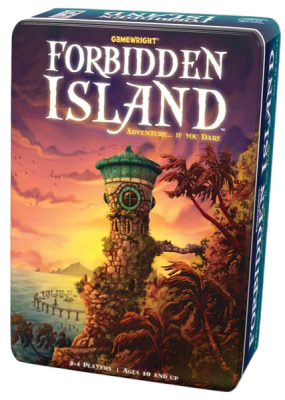
FORBIDDEN ISLAND
Buy It!:________________________________________________________ Amazon ($15.79)
Age Range with Adult Supervision: Ages 5+
Number of Players: 2-4 players.
Description: You are part of a team of 4 adventurers who must comb the ruins of an island in order to find several unique artifacts. Also, you don’t have all day; the Island is slowing sinking into the water, so after a certain number of turns, the game board of tiles will disappear from beneath you. But the best part of this game is that it is cooperative (rather than competitive): all players are part of a team, and they must take heed to help each other meet the game’s challenges so that everyone wins—because if the Island sinks, everyone loses! I can’t overstate how dramatic and educational it is for a child to play a game where the parent is an ally “against the board.”
Other Tips for Playing With a Child: This game teaches cooperation skills and deduction skills.
Reviews: http://akapastorguy.blogspot.com/2010/06/game-review-forbidden-island.html
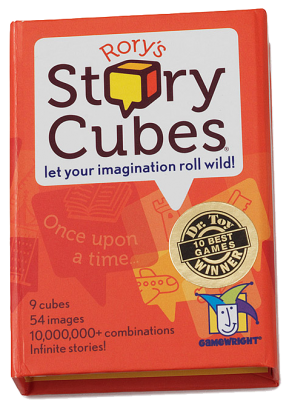
RORY'S STORY CUBES
Buy It!:________________________________________________________ Amazon ($7.85)
Age Range with Adult Supervision: Ages 2+. (see note)
Number of Players: 1-12 players. Best with 2-3 players.
Description: Games don’t get any simpler than this. Pick up the dice, roll them, and you’ll see cute little face-up images, which serve as visual prompts for you and your child to narrate out loud a spontaneous story of your own design. No parent needs to be reminded just how much children of all ages love to have stories told to them. But do you realize how much they also love to tell stories themselves? They just need a little help doing it, and the visual prompts on these dice provide exactly that. In addition to telling stories by themselves, you can use the dice to tell cooperative stories, whereby you and your children take turns incorporating one of the dice’s prompts into your every-evolving story. This game teaches oral language command, interpretation, and creativity.
Expansions: There are countless “expansion” sets of dice you can buy to add more options to your original game. However, I didn’t find the “Actions” expansion to be very useful, since the primary concepts people brainstorm are objects and places (not verbs, which is what the Actions expansion is about). So I’d avoid that one.
Other Tips for Playing With a Child: One thing to watch out for is that many children will interpret the images on the dice too literally, and this will lead to a less creative story. The father in the review explains this problem by holding up a die with a picture of a jet plane to his kids and saying, “the image could mean a jet plane, or traveling or moving as fast as a jet plane.” His kids understood his analogy, and the game not only became much more interesting for them, but they told better stories! Finally, with children less than 3 years old, it’s likely that they will still enjoy watching you roll the dice and narrating a story through their pretty images, but understand that at this point, the game becomes more of a ‘toy’ and less of a ‘game’ (not that there’s nothing wrong with that!). And of course, watch out for choking hazards on the dice.
Reviews: http://fathergeek.com/rorys-story-cubes/
This is one father’s fantastic review of the story-telling powers unleashed by his 4 and 8-year old when they play this game.
http://bilingualmonkeys.com/the-importance-of-stories-and-storytelling-in-raising-bilingual-kids/
This review discusses how especially important storytelling games are for children raised in homes where they are taught to be bilingual.

